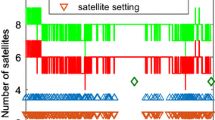Abstract
The multi-mode positioning of Global Navigation Satellite System (GNSS) could improve the positioning accuracy compared with the traditional single-mode positioning, as the number of observed satellites is increased and the geometry distribution of visual satellites is improved. In this paper, pseudorange fusion algorithm is proposed to combine the pseudorange observations of both Global Positioning System (GPS) and BeiDou Navigation System (BDS) to obtain the position equation for dual-mode positioning. Then the weighted least square method is used to solve this position equation. Besides that, the proposed pseudorange fusion algorithm is implemented in a GPS/BDS software receiver. According to positioning result comparison of single-mode and dual-mode positioning, it is concluded that the dilution of precision (DOP) of the dual-mode positioning is smaller and the positioning accuracy is more precision.
Access this chapter
Tax calculation will be finalised at checkout
Purchases are for personal use only
Similar content being viewed by others
References
Zhang P, Zeng Q, Zhu X, Pei L. Research progress of Global Navigation Satellite System software receiver. J Hebei Univ Sci Technol. 2016;3:220–9.
Juang J, Tsai C, Chen Y. Development of a PC-based software receiver for the reception of Beidou navigation satellite signals. J Navig. 2013;66:701–18.
Lu Y. Beidou/GPS dual-mode software receiver principle and implementation technology. Beijing: Publishing House of Electronics Industry; 2016.
Li X, Ge M, Dai X. Accuracy and reliability of multi-GNSS real-time precise positioning: GPS, GLONASS, BeiDou, and Galileo. J Geodesy. 2015;89(6):607–35.
Kim G, So H, Jeon S, Kee C, Cho Y, Choi W. The development of modularized post processing GPS software receiving platform. In: 2008 international conference on control, automation and systems, Seoul; 2008. p. 1094–8.
Zhang Z. Design and research of GPS software receiver and its key technologies based on VC++. Tianjin: Nankai University; 2013.
Wang Q. The design and implementation positioning algorithm for GPS/BD2 dual-mode receiver. Southeast University; 2016.
Yu C, Qin H, Jin T. Design of weighted least squares positioning algorithm for BD2/GPS based on CNO. In: China Satellite Navigation Academic annual conference; 2015.
Afifi A, El-Rabbany A. Improved dual frequency PPP model using GPS and BeiDou observations. J Geodetic Sci. 2017;7(1):1–8.
Acknowledgements
This research is partially supported by the Chinese National Science Foundation (No. 61501079 and 61231006), Doctoral Scientific Research Starting Foundation of Liaoning Province (No. 2017011243 and No. 2017011149), Remote Sensing Youth Science and Technology Innovative Research, Dalian Technology Star Program, Foundation of Liaoning Educational Committee (No. L2015059) and the Fundamental Research Funds for the Central Universities (No. 3132018182 and 3132016317).
Author information
Authors and Affiliations
Corresponding author
Editor information
Editors and Affiliations
Rights and permissions
Copyright information
© 2020 Springer Nature Singapore Pte Ltd.
About this paper
Cite this paper
Yi, J., Yue, F., Yan, H., Han, S. (2020). Pseudorange Fusion Algorithm for GPS/BDS Software Receiver. In: Liang, Q., Liu, X., Na, Z., Wang, W., Mu, J., Zhang, B. (eds) Communications, Signal Processing, and Systems. CSPS 2018. Lecture Notes in Electrical Engineering, vol 516. Springer, Singapore. https://doi.org/10.1007/978-981-13-6504-1_146
Download citation
DOI: https://doi.org/10.1007/978-981-13-6504-1_146
Published:
Publisher Name: Springer, Singapore
Print ISBN: 978-981-13-6503-4
Online ISBN: 978-981-13-6504-1
eBook Packages: EngineeringEngineering (R0)




